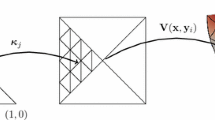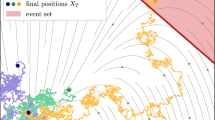Abstract
We present an efficient method for the numerical realization of elliptic PDEs in domains depending on random variables. Domains are bounded, and have finite fluctuations. The key feature is the combination of a fictitious domain approach and a polynomial chaos expansion. The PDE is solved in a larger, fixed domain (the fictitious domain), with the original boundary condition enforced via a Lagrange multiplier acting on a random manifold inside the new domain. A (generalized) Wiener expansion is invoked to convert such a stochastic problem into a deterministic one, depending on an extra set of real variables (the stochastic variables). Discretization is accomplished by standard mixed finite elements in the physical variables and a Galerkin projection method with numerical integration (which coincides with a collocation scheme) in the stochastic variables. A stability and convergence analysis of the method, as well as numerical results, are provided. The convergence is “spectral” in the polynomial chaos order, in any subdomain which does not contain the random boundaries.
Similar content being viewed by others
References
Babuška, I., Nobile, F., Tempone, R.: A stochastic collocation method for elliptic partial differential equations with random input data. SIAM J. Numer. Anal. (to appear)
Babuška I., Tempone R., Zouraris G.E. (2004). Galerkin finite element approximations of stochastic elliptic partial differential equations. SIAM J. Numer. Anal. 42: 800–825
Bertoluzza S. (1997). Interior estimates for the wavelet Galerkin method. Numer. Math. 78: 1–20
Brezzi F., Fortin M. (1991). Mixed and Hybrid Finite Element Methods. Springer, New York
Cameron R., Martin W. (1947). The orthogonal development of nonlinear functionals in series of Fourier-Hermite functionals. Ann. Math. 48: 385–392
Caflisch, R.E.: Monte Carlo and quasi-Monte Carlo methods. Acta Numer., 1–49 (1998)
Canuto C., Hussaini M.Y., Quarteroni A., Zang T.A. (2006). Spectral Methods. Fundamentals in Single Domains. Springer, Berlin
Deb M.K., Babuška I., Oden J.T. (2001). Solution of stochastic partial differential equations using Galerkin finite element techniques. Comput. Methods Appl. Mech. Eng. 190: 6359–6372
Ditzian Z., Totik V. (1987). Moduli of Smoothness. Springer, New York
Ghanem R., Spanos P.D. (1991). Stochastic Finite Elements—A Spectral Approach. Springer, Berlin
Gerstner T., Griebel M. (1998). Numerical integration using sparse grids. Numer. Algorithms 18: 209–232
Girault V., Glowinski R. (1995). Error analysis of a fictitious domain method applied to a Dirichlet problem. Japan J. Ind. Appl. Math. 12: 487–514
Glowinski R., Pan T.S., Périaux J. (1993). A least squares/fictitious domain method for mixed problems and Neumann problems. In: Lions, J.L., Baiocchi, C. (eds) Boundary Value Problems for Partial Differential Equations and Applications, pp 159–178. Masson, Paris
Glowinski R., Pan T., Periaux J. (1994). A fictitious domain method for Dirichlet problem and applications. Comput. Methods Appl. Mech. Eng. 111: 283–303
Haslinger J., Kozubek T. (2000). A fictitious domain approach for a class of Neumann boundary value problems with applications in shape optimization. East-West J Numer. Math. 8: 1–26
Haslinger, J., Kozubek, T., Kucera, R., Peichl, G.: Projected Schur complement method for solving non-symmetric systems arising from a smooth fictitious domain approach. Numer. Linear Algebra Appl. (2007) (to appear)
Haslinger J., Kozubek T., Kunisch K., Peichl G. (2003). Shape optimization and fictitious domain approach for solving free boundary problems of Bernoulli type. COAP 26: 231–251
Haslinger J., Mäkinen R.A.E. (2003). Introduction to Shape Optimization, Theory, Approximation and Computation. SIAM, Philadelphia
Hosden, S., Walters, R.W., Perez, R.: A non-intrusive polynomial chaos method for uncertainty propagation in CFD simulations. AIAA Paper 2006-0891
Kleiber M., Hien T.D. (1992). The Stochastic Finite Element Method. Basic Perturbation Technique and Computer Implementation. Wiley, Chichester
Kucera, R., Kozubek, T., Haslinger, J.: On solving non-symmetric saddle-point systems arising from fictitious domain approaches. In: Proceedings of PANM06, Prague, Czech Republic, pp. 165–171 (2006)
Loève M. (1977). Probability Theory. Springer-Verlag, Berlin
Mastroianni G., Monegato G. (2006). Truncated approximation processes on unbounded intervals and their applications. Rend. Circ. Mat. Palermo 55: 123–139
Mathelin I., Hussaini M.Y., Zang T.A. (2005). Stochastic approaches to uncertainty quantification in CFD simulations. Numer. Algorithms 38: 209–236
Matthies, H.G., Keese, A.: Galerkin methods for linear and nonlinear elliptic stochastic partial differential equations, pp. 1295–1331 in [28]
Mommer M.S. (2006). A smoothness preserving fictitious domain method for elliptic boundary-value problems. IMA J. Numer. Anal. 26: 503–524
Oksendal B. (1998). Stochastic Differential Equations—An Introduction with Applications. Springer, Berlin
Schuëller, G.I. (ed.): Computational Methods in Stochastic Mechanics and Reliability Analysis. Special Issue 12–16, Comput. Methods Appl. Mech. Eng. 194 (2005)
Schwab Ch., Todor R.A. (2003). Sparse finite elements for stochastic elliptic problems-higher order moments. Computing 71: 43–63
Todor, R.A., Schwab, Ch.: Convergence rates for sparse chaos approximations of elliptic problems with stochastic coefficients. Research Rep. No. 2006-05, Seminar für Angewandte Mathematik, ETH Zurich
Walters, R.W.: Towards stochastic fluid mechanics via polynomial chaos. AIAA Paper 2003-0413
Wiener N. (1938). The homogeneous chaos. Am. J. Math. 60: 897–936
Xiu D., Karniadakis G.E. (2002). The Wiener–Askey polynomial chaos for stochastic differential equations. SIAM J. Sci. Comput. 24: 619–644
Xiu D., Karniadakis G.E. (2003). Modeling uncertainty in flow simulation via generalized polynomial chaos. J. Comput. Phys. 187: 137–167
Xiu D., Tartakovsky D.M. (2006). Numerical methods for differential equations in random domains. SIAM J. Sci. Comput. 28: 1167–1185
Author information
Authors and Affiliations
Corresponding author
Rights and permissions
About this article
Cite this article
Canuto, C., Kozubek, T. A fictitious domain approach to the numerical solution of PDEs in stochastic domains. Numer. Math. 107, 257–293 (2007). https://doi.org/10.1007/s00211-007-0086-x
Received:
Revised:
Published:
Issue Date:
DOI: https://doi.org/10.1007/s00211-007-0086-x




